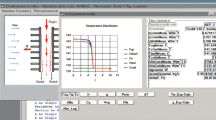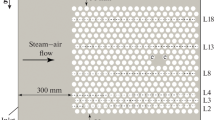Abstract
To increase the efficiency, reliability, and compactness of condensers designed for thermal and nuclear power industries and chemical and many other facilities employing condensers and to reduce their cost, the models of the condensation processes on smooth horizontal tubes assembled in bundles of different arrangements need to be improved. The previous publications of the authors reported the results of a study of condensation processes using a comprehensive CFD model. The key element of this model is a one-dimensional condensate film model, which was previously validated by the authors basically against the experimental data on vapor condensation from a moving gas-vapor mixture with a high content of noncondensables on a horizontal tube bundle, while the сombination and interrelation of running physical processes and the uncertainty (error) in the data for tube bundles, compared with the data for a single tube, made it more difficult to validate the above-mentioned film model in detail. The results of the validation of the previously proposed liquid film model and of a somewhat simplified version of the model against available data on the characteristics of condensation processes on the surface of a smooth horizontal tube with any direction of an external flow of saturated dry vapor are presented. The simplified liquid film model includes only a one-dimensional condensate continuity equation, the solution of which requires information on the distribution of the wall temperature along the tube perimeter and of the shear stresses over the liquid-gas interface. The tube wall temperature from the one-dimensional (in terms of the angular coordinate) heat conduction equation, and the distribution of shear stresses on the film surface was found from the solution of the boundary layer equations for a laminar flow near a cylinder, taking into account the uniform distribution of gas mass removal on its surface. To determine the film characteristics under “flooding” conditions, a new numerical upwind scheme is proposed, which considers the features of the velocity profile in the film. The proposed models were validated against experimental data for the downward flow of vapor (water and refrigerant R-113, more than 500 points) and a few data for other directions of the velocity vector of the external vapor flow.















Similar content being viewed by others
REFERENCES
RD 34.30.104. Guidelines for Thermal Calculation of Surface Condensers of High-Power Turbines at Thermal and Nuclear Power Plants (SPO Soyuztekhenergo, Moscow, 1982).
Standards for Steam Surface Condensers (Heat Exchange Inst., Cleveland, Oh., 2012).
Recommended Practice for the Design of Surface Type Steam Condensing Plant (British Electrical and Allied Manufacturers’ Association, London, 1971).
B. G. Jeon, D. Y. Kim, C. W. Shin, and H. C. No, “Parametric experiments and CFD analysis on condensation heat transfer performance of externally condensing tubes,” Nucl. Eng. Des. 293, 447−457 (2015).
A. Dehbi, “A correlation spanning the entire laminar convection regime for vapor condensation over a horizontal tube in the presence of a noncondensable gas,” Int. Commun. Heat Mass Transfer 128, 105619 (2021).
A. Dehbi, “Development of a general correlation for free convection vapor condensation over a horizontal tube in the presence of a noncondensable gas,” Int. Commun. Heat Mass Transfer 123, 105210 (2021).
K. B. Minko, V. I. Artemov, G. G. Yankov, and O. O. Milman, “A mathematical model of forced convection condensation of steam on smooth horizontal tubes and tube bundles in the presence of noncondensables,” Int. J. Heat Mass Transfer 140, 41−50 (2019). https://doi.org/10.1016/j.ijheatmasstransfer.2019.05.099
K. B. Minko, V. I. Artemov, G. G. Yan’kov, and V. S. Krylov, “Verification of the mathematical model of steam film condensation from a flowing steam-air mixture on a bundle made of horizontal tubes,” Therm. Eng. 66, 804–811 (2019). https://doi.org/10.1134/S004060151911003X
K. B. Minko, V. I. Artemov, G. G. Yan’kov, and V. S. Krylov, “Numerical simulation of steam condensation in a steam-gas mixture flow in a variable-section channel with a bundle of smooth horizontal tubes,” Therm. Eng. 66, 928–935 (2019). https://doi.org/10.1134/S0040601519120061
K. B. Minko, V. I. Artemov, and Yankov G. G., “Numerical simulation of the formation process of zones with increased air content in tube bundles during condensation of steam containing small concentrations of air,” Therm. Eng. 69, 252–258 (2022). https://doi.org/10.1134/S0040601522040048
S. P. Aktershev, Stability, Nonlinear Waves, and Transport Processes in Liquid Films under Complex Conditions, Doctoral Dissertation in Engineering (S. S. Kutateladze Inst. of Thermophysics, Siberian Branch of the Russian Academy of Sciences, Novosibirsk, 2016).
B. S. Petukhov and V. V. Kirillov, “On the issue of heat transfer during turbulent flow of fluid in tubes,” Teploenergetika, No. 4, 63–65 (1958).
P. Saikrishnan and S. Roy, “Non-uniform slot injection (suction) into water boundary layers over (i) a cylinder and (ii) a sphere,” Int. J. Eng. Sci. 41, 1351–1365 (2003).
K. Hiemenz, “Die Grenzschicht an einem inden gleichförmigen Flüssigkeitsstrom eingetauchten geraden Kreiszylinder,” Dinglers Polytech. J. 326, 321−324 (1911).
P. Virtanen, R. Gommers, T. E. Oliphant, and M. Haberland, “SciPy 1.0: Fundamental algorithms for scientific computing in Python,” Nature Methods 17, 261−272 (2020).
ANES Code. http://anes.ch12655.tmweb.ru/. Accessed February 1, 2022.
F. Menter, J. C. Ferreira, T. Esch, and B. Konno, “The SST turbulence model with improved wall treatment for heat transfer predictions in gas turbines,” in Proc. 8th Int. Gas Turbine Congr., Tokyo, Japan, 2–7 Nov. 2003 (Gas Turbine Society of Japan, Tokyo, 2003), paper id. IGTC2003-TS-059, pp. 2–7.
J. S. Son and T. J. Hanratty, “Velocity gradients at the wall for flow around a cylinder at Reynolds numbers from 5:103 to 105,” J. Fluid Mech. 35, 353–368 (1969).
J. H. M. Fransson, P. Konieczny, and P. H. Alfredsson, “Flow around a porous cylinder subject to continuous suction or blowing,” J. Fluids Struct. 19, 1031−1048 (2004).
A. A. Nicol, A. Bryce, and A. S. A. Ahmed, “Condensation of a horizontally flowing vapour on a horizontal cylinder normal to the vapour stream,” in Proc. 6th Int. Heat Transfer Conference, Toronto, Canada, Aug. 7–11, 1978 (Hemisphere, Washington, DC, 1978), pp. 401–406.
W. C. Lee, Filmwise Condensation on a Horizontal Tube in the Presence of Forced Convection and Non-Condensing Gas, Doctoral Dissertation (Univ. of London, London, 1982).
D. W. Nobbs, The Effect of Downward Vapour Velocity and Inundation on the Condensation Rates on Horizontal Tubes and Tube Banks (Univ. of Bristol, Bristol, 1975).
F. Tetsu, U. Haruo, and K. Chikatoshi, “Laminar filmwise condensation of flowing vapour on a horizontal cylinder,” Int. J. Heat Mass Transfer 15, 235–246 (1972).
A. S. Ahmed, Condensation of Steam on a Horizontal Tube with Vapour Cross Flow, MSc Dissertation (Glasgow, 1976).
T. Fujii, H. Honda, and K. Oda, “Condensation of steam on a horizontal tube — The influence of oncoming velocity and thermal condition at the tube wall,” in Proc. 18th Natl. Heat Transfer Conf., San Diego, Calif., Aug. 6–8, 1979 (ASME/AICHE, New York, 1979), pp. 35−43.
A. A. Avdeev and Yu. B. Zudin, “The influence of steam velocity on heat transfer during condensation on a horizontal cylinder placed in transverse flow,” Therm. Eng. 58, 295–300 (2011).
Funding
This investigation was funded by a grant of the Russian Science Foundation (grand no. 22-29-01457).
Author information
Authors and Affiliations
Corresponding author
Additional information
Translated by T. Krasnoshchekova
Rights and permissions
About this article
Cite this article
Minko, K.B., Artemov, V.I. & Klement’ev, A.A. Validating the Model of a Liquid Condensate Film on the Surface of a Smooth Horizontal Cylinder for Different Vapor Flow Directions. Therm. Eng. 69, 942–953 (2022). https://doi.org/10.1134/S0040601522120060
Received:
Revised:
Accepted:
Published:
Issue Date:
DOI: https://doi.org/10.1134/S0040601522120060




